The Kenya Methodist University (KeMU) is a chartered private university founded by the Methodist Church in Kenya. It is situated within woodland on the north eastern slopes of Mount Kenya, five kilometers from Meru Town. The development of KeMU is based on the 1906 Methodist Church education policy that resulted in the development of schools, industrial institutes and colleges.
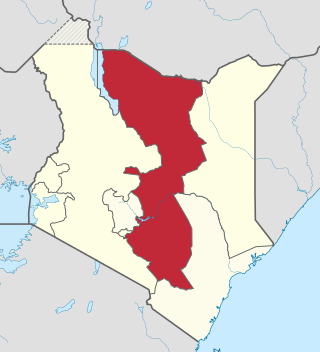
The Eastern Province of Kenya was one of 8 Provinces of Kenya. Its northern boundary ran along with that of Ethiopia; the North Eastern Province and Coast Province lay to the east and south; and the remainder of Kenya's provinces, including Central Province, ran along its western border. The provincial capital was Embu.
Embu is a town located approximately 125 kilometres (78 mi) northeast of Nairobi towards Mount Kenya. Embu served as the provincial capital of the former Eastern Province and currently serves as the headquarters of Embu County in Kenya. Located on the south-eastern foothills of Mount Kenya, the Municipality of Embu had a population of 204,979 in 2019 census. Embu is also the 8th Largest Municipality in Kenya. It is the commercial hub of the Central Eastern part of Kenya and provides an avenue for trade, tourism and highway transit between the national capital and the Northern Frontier.
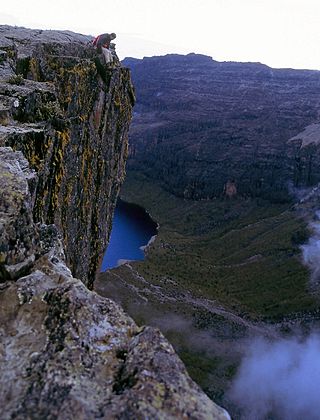
Meru County is one of the 47 counties of Kenya. It borders Isiolo County to the north, Tharaka-Nithi County to the South, Nyeri County to the southwest and Laikipia County to the west. The home of the Meru people, Meru County has a population of 1.35 million people.

Isiolo is a town in Isiolo County, of which it is the capital. It is located in the upper eastern region of Kenya and is geographically considered the center of the country Kenya. It lies 285 kilometers north of the capital Nairobi. The town grew around the local military camps, much of the population being descendants of former Somali soldiers who had fought in World War I as well as other Cushitic-speaking pastoral communities and the Ameru community. The name Isiolo originates from the Somali word ' Is ilow' which translates to forget yourself. It was a term that the local Somalis would tell newcomers who had the intention of moving back to Somalia when Kenya gained independence. The town has an estimated population of 78,250, most of them living around the outskirts of the town. Like most African cities, there has been a steady increase in the urban population in recent years, especially moving from as far as Moyale, Marsabit and Mandera. Isiolo town is also becoming a centre of interest because of its newly acquired status as a resort city cashing in on the popular Samburu and Shaba Game reserves, which have become preferred destinations after the famed Maasai Mara. Isiolo lies along the long A2 Road, leading towards Marsabit and Moyale much further north.
Kitui is a town and capital of Kitui County in Kenya, 185 kilometres east of Nairobi and 105 kilometres east of Machakos. it covers an area approximately 30,496.4 km squares and lies between latitudes 0°10 South and 3°0 South and longitudes 37°50 East and 39°0 East. It borders seven counties i.e Machakos and Makueni counties to the west, Tana River County to the east and south-east, Taita Taveta County to the south, Embu to the north-west, and Tharaka-Nithi and Meru counties to the north. Kitui became the headquarters of Kitui County after the adoption of the new constitution and the devolved government.

The Meru or Amîîrú are a Bantu ethnic group that inhabit the Meru region of Kenya. The region is situated on the fertile lands of the north and eastern slopes of Mount Kenya in the former Eastern Province.

Kenyatta University (KU) is a public research university with its main campus in Nairobi. It acquired the status of university in 1985, being the third university after University of Nairobi (1970) and Moi University (1984). As of October 2014, it was one of 23 public universities in the country.
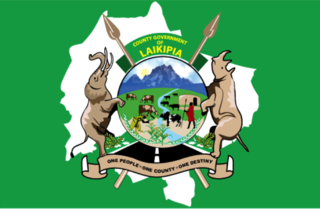
Laikipia County is one of the 47 Counties of Kenya, located on the Equator in the former Rift Valley Province of the Country. Laikipia is a cosmopolitan County and is Listed as County number 31. The county has two major urban centres: Nanyuki to the southeast, and Nyahururu to the southwest. Its County government headquarters town is Rumuruti. The County lies between latitudes 0° 18" South and 0° 51" North and between longitude 36° 11" and 37° 24' East. It borders Samburu County to the North, Isiolo County to the North East, Meru County to the East, Nyeri County to the South East, Nyandarua County to the South, Nakuru County to the South West and Baringo County to the West.
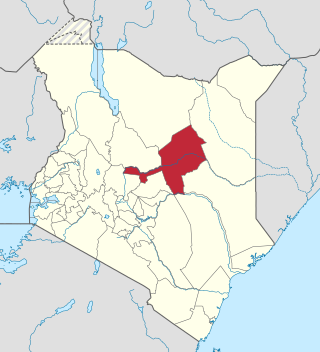
Isiolo County is a county in the former Eastern Province of Kenya. Its population is 268,002 and its capital and largest city is Isiolo. Isiolo County is to be the first county to be developed as part of the Kenya Vision 2030 program. Other upcoming urban centres are: Garbatulla, Modogashe, Kinna, Merti and Oldonyiro.The county is home to Sakuye and Borana tribes but also has a significant number of people from Turkana, Samburu, Gabra, Garre and Meru communities.

Local authorities in Kenya are the bodies controlling local governance in urban areas in Kenya.
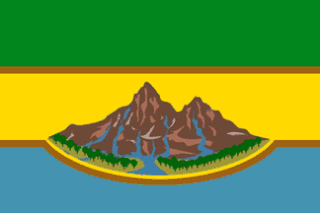
Tharaka-Nithi County is one of the 47 counties of Kenya. It was created from Kenya's Eastern Province. The county has an area of 2609 km2 and as of the 2019 census a population of 393,177.
Nkubu is a town in Kenya. It is located on the eastern slopes of Mount Kenya, within Meru County. It falls in one of the most-fertile and best-watered parts of Africa, with tea, coffee and dairy farming as the main economic activities in the area. It is also the lead town in South Imenti Constituency.

Runyenjes is the second largest town in Embu County, Kenya. It is located about 150 km from Nairobi, and 75 km from Mount Kenya, at an altitude of 1500m.The population is estimated at 58,000 people, the majority of which are the Embu People who speak Kiembu, a Bantu language, as well as Kiswahili and English, the two official languages in Kenya. The area offers scenic views, with densely wooded hills, gentle valleys, flowing streams and rivers, waterfalls, as well as small-scale farms.

Sub-counties, also known as Districts, are the decentralised units through which government of Kenya provides functions and services. At national level, sub-counties take a more administrative function like security, statistical purposes, provision of government services, etc. Even though the sub-counties are divisions of counties, powers to create new national sub-counties lies with the national government. As of 2023, there are 314 sub-counties, compared to 290 constituencies. A deputy county commissioner is appointed by the state to lead each sub-county. The sub-counties are further divided into divisions, locations and sub-locations.
Mwalimu Cooperative Savings and Credit Society Limited, also known as Mwalimu National Sacco Limited, but often referred to as Mwalimu Sacco, is a savings and credit co-operative society (Sacco) in Kenya, the largest economy in the East African Community. It is an institutional Sacco, composed of the staff of the Teachers Service Commission (TSC), TSC teachers in secondary and tertiary institutions, TSC teachers in elementary schools, the staff of Mwalimu National Sacco Limited and the spouses of the above members, when formally gainfully employed. The society is licensed and regulated by the Sacco Societies Regulatory Authority.
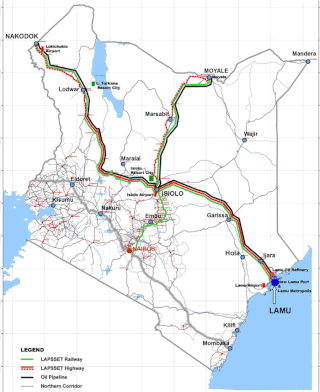
Lamu–Garissa–Isiolo Road, is a road in Kenya, and is part of the Lamu-Garissa-Isiolo-Lokichar Road, which itself is a component of the Lamu Port and Lamu-Southern Sudan-Ethiopia Transport Corridor (LAPSSET) Project.
Isaac Lenaola is a Kenyan lawyer and judge, who has served as a Justice of the Supreme Court of Kenya, since 28 October 2016.
Meru Twin Towers, also Meru Church Towers, or Meru Destiny Towers, is a real estate development, planned in the town of Meru, the county seat of Meru County in the Eastern part of Kenya. The mixed use twin towers are owned by the developers, the Jesus House of Praise International Church.












